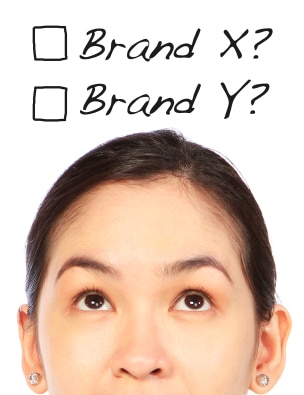 Reading Time: 4 minutes read
Reading Time: 4 minutes readBrand’s Irresistibility Quotient
When will be stop measuring Brands Irresistibility Quotient? Probably never – it comes to brand irresistibility quotient there has been some new research released today that de-mystifies (yes, scientifically) irresistibility. TNS, a global insight consultancy group has a tool they call “NeedScope” that actually measures brand irresistibility and then gives each measured brand an Irresistibility Quotient score.
A perfect score is 100.
They’ve recently put out a press release explaining this insight process and technology and I wanted to share the eight attributes that they’ve identified for irresistible brands:
The eight drivers of brand irresistibility
1. Know-how: Is your brand a credible expert?
Credible know-how is a basic hygiene factor for any would-be irresistible brand, providing the System 2 brain with conscious proof that this particular brand knows what it is doing. Know-how can be earned over time by product performance (Bang & Olufsen), instantly achieved through technological breakthroughs (Dyson) or acquired through expert endorsement (Nike and sport).
2. Momentum: Can you stay ahead of the game?
Irresistible brands evolve in ways that keep consumers interested and engaged. They remain true to the characteristics that made them irresistible while anticipating and leading change. For Coca-Cola, gradual evolution over the course of a century has delivered exactly the cadence required; for Samsung, in a category defined by constant change, a wave of high-quality innovation has been required to deliver real momentum.
3. Differentiation: Do you have the courage to stand for something?
Irresistible brands don’t just need a point of difference; they need a point of difference that really matters to consumers, and the courage to focus on this point of difference even when it means rejection by some. In Dove’s case, a differentiated and decisive brand positioning around ‘Real Beauty’ has enabled it to claim ownership of product qualities such as moisturising, in a way that others find difficult to challenge.
4. Emotion: Do you know what your emotive meaning is?
Emotion gives irresistible brands unique meaning in the eyes of their consumers, and an instinctive attraction that goes beyond rational reasons for purchase. Mastery of emotion in relation to particular consumer needs lies behind the magic of irresistible brands. For instance, a pharmaceutical brand may use white laboratories and lab coats to address an emotive need for reassurance and control; financial institutions may use symbols of tradition and power to evoke emotions of stability. Irresistible brands know what their emotive meaning needs to be.
5. Symbolism: Do you have your own emotive language?
Symbolism is the language of emotion and a key set of triggers for decisions by our fast, intuitive brain. Irresistible brands understand the symbolic meaning in everything and apply the secret language of colours, shapes and images to evoke particular emotions. In the fragrance category, perfume brands rarely use words to describe their products, but differentiate themselves through symbols such as the materials of the packaging, shape of the bottle and the colour of the liquid within it.
6. Nexus: Do the different elements of your brand add up?
Brands satisfy three layers of conscious or unconscious consumer need: functional, social and emotional. When the ways in which it addresses these needs flow naturally from one another, the brand has high Nexus. These types of brands are more convincing as the emotions they stir are strongly reflected in their function and social identity. Red Bull’s bold, adventurous proposition ladders through all layers of the brand. The social identity is young and cool, the product has many active ingredients and promises to vitalise body and mind by giving you wings.
7. Alignment: Is your brand consistent across touchpoints?
Aligning look, message and emotion across every different touchpoint is one of the greatest challenges for would-be irresistible brands. Once achieved, alignment enhances irresistibility and maximises marketing budgets. Audi’s promise of refinement and class and emotively linked product promise of cutting-edge technology and design, informs every aspect of its identity: from brand logo to retail showrooms – every touchpoint is a temple to design and technology.
8. Unity: Could your brand remain recognisable across products and categories?
Irresistible brands provide owners with a powerful asset that can often be leveraged across several products and categories, stretching their appeal while retaining an inherent unity of brand architecture. Virgin has proved an irresistible brand in categories broadly related to entertainment, where its maverick emotive positioning has strong resonance; when it stretched into Cola this brand unity was challenged. In contrast, Johnnie Walker has maintained impressive unity of brand architecture across a range of variants that enable it to appeal at many different price points.
Develop your own Irresistibility Index
As you would imagine, this process can run into BIG BUCKS — but that doesn’t mean that you can’t use this research to measure your own brand’s level of irresistibility.
You can develop your own simple index using these attributes and QuestionPro
Simply develop a question for each of the eight attributes and run it across your marketplace. You can question your customers, prospects or even pull a sample from QuestionPro’s own sampling service.
Brand irresistibility is definitely a rising way to measure profitability, so give this process a try and let us know how it worked for you.





















